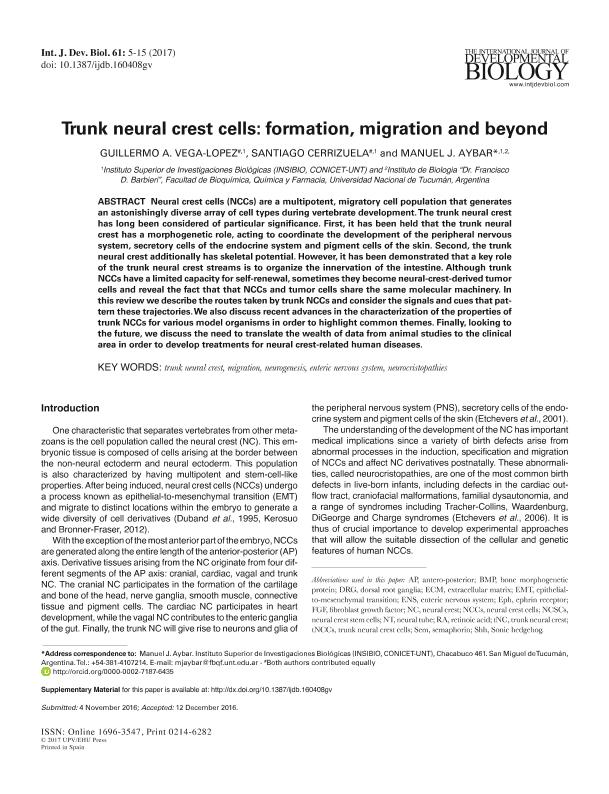Mostrar el registro sencillo del ítem
dc.contributor.author
Cerrizuela, Santiago

dc.contributor.author
Vega López, Guillermo Alfredo

dc.contributor.author
Aybar, Manuel Javier

dc.date.available
2018-07-31T21:09:15Z
dc.date.issued
2017-03
dc.identifier.citation
Cerrizuela, Santiago; Vega López, Guillermo Alfredo; Aybar, Manuel Javier; Trunk neural crest cells: Formation, migration and beyond; Universidad del País Vasco; International Journal Of Developmental Biology; 61; 1-2; 3-2017; 5-15
dc.identifier.issn
0214-6282
dc.identifier.uri
http://hdl.handle.net/11336/53692
dc.description.abstract
Neural crest cells (NCCs) are a multipotent, migratory cell population that generates an astonishingly diverse array of cell types during vertebrate development. The trunk neural crest has long been considered of particular significance. First, it has been held that the trunk neural crest has a morphogenetic role, acting to coordinate the development of the peripheral nervous system, secretory cells of the endocrine system and pigment cells of the skin. Second, the trunk neural crest additionally has skeletal potential. However, it has been demonstrated that a key role of the trunk neural crest streams is to organize the innervation of the intestine. Although trunk NCCs have a limited capacity for self-renewal, sometimes they become neural-crest-derived tumor cells and reveal the fact that that NCCs and tumor cells share the same molecular machinery. In this review we describe the routes taken by trunk NCCs and consider the signals and cues that pattern these trajectories. We also discuss recent advances in the characterization of the properties of trunk NCCs for various model organisms in order to highlight common themes. Finally, looking to the future, we discuss the need to translate the wealth of data from animal studies to the clinical area in order to develop treatments for neural crest-related human diseases.
dc.format
application/pdf
dc.language.iso
eng
dc.publisher
Universidad del País Vasco

dc.rights
info:eu-repo/semantics/openAccess
dc.rights.uri
https://creativecommons.org/licenses/by-nc-sa/2.5/ar/
dc.subject
Enteric Nervous System
dc.subject
Migration
dc.subject
Neurocristopathies
dc.subject
Neurogenesis
dc.subject
Trunk Neural Crest
dc.subject.classification
Otras Ciencias Biológicas

dc.subject.classification
Ciencias Biológicas

dc.subject.classification
CIENCIAS NATURALES Y EXACTAS

dc.title
Trunk neural crest cells: Formation, migration and beyond
dc.type
info:eu-repo/semantics/article
dc.type
info:ar-repo/semantics/artículo
dc.type
info:eu-repo/semantics/publishedVersion
dc.date.updated
2018-07-30T13:48:25Z
dc.identifier.eissn
1696-3547
dc.journal.volume
61
dc.journal.number
1-2
dc.journal.pagination
5-15
dc.journal.pais
España

dc.journal.ciudad
Bilbao
dc.description.fil
Fil: Cerrizuela, Santiago. Consejo Nacional de Investigaciones Científicas y Técnicas. Centro Científico Tecnológico Conicet - Tucumán. Instituto Superior de Investigaciones Biológicas. Universidad Nacional de Tucumán. Instituto Superior de Investigaciones Biológicas; Argentina
dc.description.fil
Fil: Vega López, Guillermo Alfredo. Consejo Nacional de Investigaciones Científicas y Técnicas. Centro Científico Tecnológico Conicet - Tucumán. Instituto Superior de Investigaciones Biológicas. Universidad Nacional de Tucumán. Instituto Superior de Investigaciones Biológicas; Argentina
dc.description.fil
Fil: Aybar, Manuel Javier. Consejo Nacional de Investigaciones Científicas y Técnicas. Centro Científico Tecnológico Conicet - Tucumán. Instituto Superior de Investigaciones Biológicas. Universidad Nacional de Tucumán. Instituto Superior de Investigaciones Biológicas; Argentina
dc.journal.title
International Journal Of Developmental Biology

dc.relation.alternativeid
info:eu-repo/semantics/altIdentifier/url/http://www.ijdb.ehu.es/web/paper.php?doi=160408gv
dc.relation.alternativeid
info:eu-repo/semantics/altIdentifier/doi/https://dx.doi.org/10.1387/ijdb.160408gv
Archivos asociados
